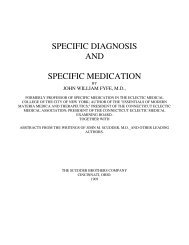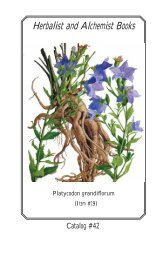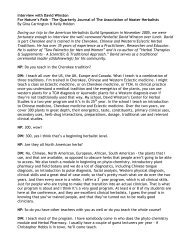MEDlCINAL PLANTS OF JAMAICA. PARTS 1 & 11.
MEDlCINAL PLANTS OF JAMAICA. PARTS 1 & 11.
MEDlCINAL PLANTS OF JAMAICA. PARTS 1 & 11.
Create successful ePaper yourself
Turn your PDF publications into a flip-book with our unique Google optimized e-Paper software.
MENTHA VIRIDIS L. Garden Mint: Black or Sweet mint.<br />
The plant, introduced into the gardens of Jamaica, is much used as a medicinal herb. Tea is prepared by<br />
infusion or decoction and is used as a general beverage and for stomach trouble. It is sometimes used with gin<br />
or rum for stomach-ache and vomiting. These uses can be traced back to the early writers on Jamaican<br />
medicinal plants. The essential oil contains l-carvone (about 54-66 per cent). I-limonene and phellandrine and<br />
d-pinene. (2, 3, 14, IS, 23, 26, 27).<br />
MICROMERIA BROWNEI (Sw.) Benth. Pennyroyal (Pennyrial).<br />
The leaves are used to make tea for stomach pains. Beckwith does not mention this use but gives a<br />
number of other uses including a rather curious 'cure' for a catarrhal cold in which a poultice of beaten leaves<br />
moistened with rum is applied to a small bare patch on top of the head. 'The water will run out of your nose and<br />
cure the complaint'. It would also seem that pennyroyal has some reputation as an abortifacient either in conjunction<br />
with cerasee and marigold or 'boiled with a rusty nail'. (2, 15).<br />
MICROMERIA VIMINEA (L.) Urb. Peppermint.<br />
Beckwith, identifying this species as peppermint, says that it is used with ginger to make tea for colic.<br />
(2, 15).<br />
OCIMUM MICRANTHUM Willd. Wild Barsley: Mosquito Bush, Wild Basil.<br />
Used as a general beverage. For fever and pain the decoction is taken as a drink and also as a bath.<br />
Alternatively the body may be rubbed with the leaves. For colds the leaves may be ground up to provide a snuff,<br />
and a bath with ginger root added may be used. It is also probably used as a laxative for babies. In the Grenadines<br />
and in Jamaica it is considered valuable for difficult menstruation. In Antigua it was, and may still be,<br />
used for bronchitis, colic, and convulsions in children. (2, 13, 27).<br />
OCIMUM BASILICUM L. Barsley.<br />
This plant is grown in gardens and, in addition to its use in cooking, it is employed in a similar manner<br />
to the wild species. Ocimum spp. are used in Trinidad, where they are called mosquito bush, in the treatment of<br />
colds and are hung in the houses to keep away mosquitoes. O. micranthum is a native Trinidadian species. (13,<br />
15).<br />
SALVIA SEROTINA L. Chicken Weed or Bitters: Wild Sage.<br />
Used to make tea as a general beverage for colic, biliousness. constipation, fever and for the blood'. It is<br />
also used, 'rubbed up', as an application to scratches, especially for a baby. It may also be used for skin<br />
complaints such as eczema. In Africa a number of Salvia species are used for these purposes. In Jamaica it is<br />
considered to be good for night sweats. (2).<br />
LAURACEAE<br />
About a thousand woody and herbaceous species mainly of warmer regions. All possess oil cells in most<br />
parts, producing volatile oils of commercial importance, e.g. oils of camphor, cinnamon and sassafras. The<br />
volatile oils contain aldehydes, alcohols, hydrocarbons, esters, free acids and other constituents. Mucilage, fats<br />
(in the fruits and seeds). and alkaloids such as beeberine and laureline occur.<br />
CINNAMOMUM ZEYLANICUM Breyn. Cinnamon.<br />
Cinnamon twigs and leaves are sold in Jamaican markets. Boiling water poured on to them makes a<br />
drink which may also be taken on corn meal porridge. It is said to be good for the stomach. It is thought to have<br />
been introduced into Jamaica in 1782 by Admiral Rodney. The bark gives 0.8 to 2 per cent volatile oil which is<br />
a carminative, an antiseptic and a stimulant. The oil contains 50 to 65 per cent cinnamic aldehyde; 4 to 10 per<br />
cent phenols of which eugenol is the principle one; hydrocarbons including pinene, phellandrene, and<br />
caryophyllene; and small amounts of alcohols, ketones and estels. The leaf oil, of varying composition, contains<br />
a high percentage (70-95) of eugenol.







